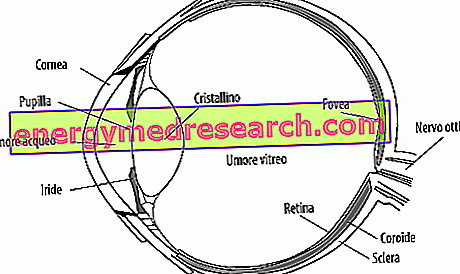Generality
Delirium tremens is an acute and severe psychotic manifestation of alcohol withdrawal.

In subjects suffering from chronic alcoholism, this condition usually begins 48-72 hours after the reduction or suspension of the consumption of alcoholic beverages.
Delirium tremens is characterized by somatic and psychic symptoms, such as strong psychomotor agitation, hallucinations, tremors and disturbances of consciousness.
Delirium tremens is to be considered a medical urgency ; the treatment is essentially based on the constant monitoring of the patient's general conditions and on support interventions, such as the administration of B vitamins and rehydration.
What's this
Delirium Tremens: definition
Delirium tremens is a fairly common psychotic disorder (or psychosis ) among alcoholics. This pathological reaction is induced by chronic alcohol abuse and, substantially, can be defined as a manifestation of the consequent withdrawal syndrome .
The term " delirium tremens " comes from the Latin and literally means "trembling delirium".
Causes and Risk Factors
Delirium tremens is one of the alcohol related diseases and, more in detail, belongs to the group of acute psychotic disorders .
Alcoholism: key points
- Alcoholism (or alcoholism ) is a set of disorders resulting from an intoxication of the organism related to the consumption of large quantities of alcohol. The harmful effects caused by alcoholic beverages are due to the action of ethyl alcohol (or ethanol ), a substance that depresses the central nervous system. Once ingested, the alcohol is rapidly absorbed in the stomach and intestines and diffuses to all the tissues of the body, gathering, however, in greater quantities in the liver and in the brain.
- Alcohol addiction is characterized by an obsessive compulsive search for alcoholic beverages (eg need to drink in the morning, just woken up and so on) and by addiction and tolerance (ie, to achieve a certain effect, the individual is forced to drink more and more alcohol).
- The abrupt cessation of chronic alcohol consumption causes the withdrawal syndrome . Usually, within 2-3 days of suspension, symptoms and signs of hyperactivity of the central nervous system occur up to delirium tremens.
Why do we suffer from Delirium Tremens?
Delirium tremens arises in an acute way and leads to somatic and psychotic symptoms, usually 48-72 hours after abstinence from alcohol .
The exact underlying causes of delirium tremens have not yet been fully clarified, but it is known to be a pathological reaction associated with prolonged intake of excessive amounts of ethyl alcohol and, as such, is a manifestation of chronic alcoholics . Ethanol induces an addiction in those who abuse it; when the intake of this substance is reduced or suspended, there is a withdrawal syndrome.
Triggering or aggravating factors
Delirium tremens appears in subjects suffering from chronic alcoholism and, in most cases, depends on:
- From a sudden interruption of alcohol consumption (eg hospitalization, forced deprivation following incarceration, etc.);
or
- From the ingestion of large quantities of alcohol after a period of abstinence from the same.

However, the appearance of delirium tremens can be determined by several other triggers, which include:
- Infectious diseases;
- Physical and mental traumas;
- Surgical interventions;
- Feverish states;
- Great physical efforts.
Delirium tremens mainly affects middle-aged adults, but can also occur in young people.
Symptoms and Complications
Delirium tremens is a manifestation that occurs in subjects suffering from chronic alcoholism, usually 48-72 hours from the beginning of the suspension of the consumption of alcoholic beverages. From the temporal point of view, however, it should be noted that the condition can develop from 1 to 8 days after abstinence.
Delirium Tremens: how does it start?
The acute stage of delirium tremens is usually preceded by a series of prodromal symptoms, accompanied by an aggravation of the general picture. This period is called predelirium or delirium latente .
The prodromal phase is followed by acute delirium, in which the symptoms manifest themselves in more serious forms and a worsening of the patient's health conditions is required.
The acute stage of delirium tremens is precipitated by sudden interruption of alcohol consumption, trauma, surgery, fever or other triggering factors.
From the clinical point of view, delirium tremens can manifest itself in different levels of severity, ie from mild to more severe forms:
- Predelirium or delirium latente (pre-delusional state in which the prodromal symptoms occur);
- Isolated tremor;
- Generalized tremor;
- Confusional state with associated tremor (delirium proper);
- Generalized epileptic attack.
Initially, the patient appears alert, but has the following somatic and psychic symptoms:
- Increased heart rate (tachycardia);
- Increased body temperature (hyperthermia);
- Profuse sweating;
- Anxiety attacks;
- Motor restlessness;
- Loss of appetite;
- Sleep disorders (insomnia, nightmares and night terror);
- Tremor;
- Ataxia (neurological disorder characterized by progressive loss of motor coordination);
- Confusion and space-time disorientation;
- Dizziness.

Hallucinations and delirium
Subsequently, mostly visual hallucinations begin to appear, often with terrifying content. These manifestations of delirium tremens fit into the picture composed of restlessness and confusion and in turn involve agitation and fear.
The hallucinations of delirium tremens can also be tactile, olfactory and auditory, in many cases accusatory and threatening.
Patients are sensitive to numerous sensory stimuli, in particular to objects seen in semi-darkness.
For example, the subject suffering from delirium tremens agitates referring to seeing insects crawling on his body or trying to escape the threats of hallucinations by hiding and sheltering; vestibular disorders can create the impression that the floor is moving or the walls are falling.
Sleep is also disturbed and insomnia, terrifying dreams or nightmares can occur.
Delirium is always accompanied by tremor and marked psychomotor agitation ; this manifestation can be varied in content, but generally, delusional ideas are jealous or persecutory .
Tremor
The tremor that manifests itself in the delirium tremens is continuous and violent. Initially, this symptom can be localized to fingers, legs and hands, but can also extend to the head and trunk.
On some occasions, delirium tremens can begin in a rather dramatic way, with tonic-clonic seizures generalized to the whole body ( alcoholic epilepsy ).
Ataxia is remarkable and care must be taken to prevent self-injurious gestures or movements .
Confusional state
Delirium tremens is characterized by an increasing confusional state, during which the subject appears disoriented, agitated and speaks continuously, in an incoherent manner.
At the same time, difficulties may arise in maintaining attention, anxiety, confabulations and disturbances of consciousness.
After a few days of delirium tremens, the patient falls into a long and deep sleep . Upon awakening, the patient can manifest a partial amnesia of what happened.
Delirium Tremens: possible consequences
Often, delirium tremens is accompanied by gastro-intestinal disorders, difficulty in urinating (up to anuria) and hepato-renal syndrome .
The progressive aggravation of the patient's general condition is often related to:
- Dehydration due to profuse sweating and excessive vomiting;
- Electrolyte imbalance for malabsorption and concomitant malnutrition.
Delirium tremens may overlap with Korsakoff syndrome .
During an episode of delirium tremens, the risk of mortality increases in the event of:
- Hyperthermia;
- Cardiac arrhythmias;
- Epileptic seizures (or related complications);
- Other medical disorders.
This can be reduced if the patient with delirium tremens is promptly treated.
Diagnosis

The diagnosis of delirium tremens is often clinical and, according to the DSM (Diagnostic and Statistical Manual of Mental Disorders), is formulated when the criteria for abstinence from alcohol associated with those to define delirium are simultaneously present.
Diagnostic criteria
STBY SYNDROME - At least two of the following symptoms are concomitant with cessation of intake of large quantities of ethyl alcohol:
- Hyperactivity of the autonomic nervous system;
- Hand tremor;
- Insomnia;
- Nausea and / or vomiting;
- Hallucinations;
- Psychomotor agitation;
- Anxiety;
- Tonic-clonic epileptic seizure.
DELIRIUM - The diagnostic criteria are:
- Reduced attention with memory deficits, orientation, visual-spatial skills and language;
- Disorders in memory, language and / or perception, in the absence of coma or neuro-cognitive disorders.
Furthermore, for the general classification, diagnostic tests (clinical, radiological and laboratory) such as:
- Measurement of blood alcohol level and blood glucose (acute alcoholism);
- Liver function test, coagulation profile (PT / PTT) and complete blood count (chronic alcoholism);
- Investigations to exclude lesions of the central nervous system and infections, such as CT and lumbar puncture (abstinence and severe toxicity).
Treatment
Delirium tremens is a severe manifestation and can endanger the patient's life. In cases where the general conditions are compromised and in the absence of supportive treatment, this condition can be fatal.
Delirium tremens management requires urgent hospitalization .
Course and possible outcomes
Delirium tremens is a medical emergency and can lead to death in about 30% of untreated patients. Sometimes, this condition can be fatal even though the therapy provided is adequate (5-10% of cases). Death from delirium tremens occurs mainly due to cardiovascular insufficiency .
As a rule, the course of delirium tremens is self-limiting and should be followed by medical personnel during hospitalization. In particular, it is important to keep the patient's general condition under control, rehydrating and feeding it, using, if necessary, an intravenous infusion .
Remission usually begins within 12-24 hours from the acute stage, and if there are no signs of marked improvement during this time, it is important to exclude other associated conditions, such as:
- Electrolytic alterations;
- Alcoholic hepatitis;
- Subdural hematoma;
- Renal disorders.
How can Delirium Tremens be treated?
The treatment of delirium tremens includes supportive measures to detoxify the patient and manage the alcohol withdrawal syndrome. In general, admission to a hospital (sometimes in intensive care) is required with close monitoring of vital signs and liver and kidney function; at the same time, a supportive therapy with hydration, nutritional support and metabolic control (in particular, of electrolytes and glycaemia) is indicated.
In the case of inadequate apnea or breathing, the treatment of delirium tremens involves endotracheal intubation and mechanical ventilation.
Until complete disappearance of symptoms, patients with a severe withdrawal syndrome can be treated with the administration of:
- B vitamins (such as thiamine or multivitamin complexes) to correct any deficiency and prevent Wernicke's encephalopathy;
- Antipsychotics and benzodiazepines (favor behavioral control and prevent self-injurious phenomena secondary to psychomotor agitation).
Drug therapy can be modified according to the severity of delirium tremens.
Treatment should also include appropriate psychotherapy and adherence to rehabilitation programs dedicated to the treatment of alcohol dependence problems.



